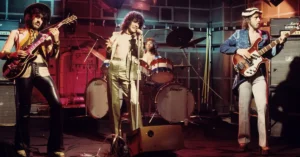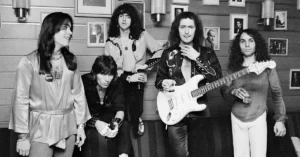AC/DC: The Electrifying Force of Rock ‘n’ Roll
The Origins of AC/DC: A Family Affair
AC/DC was formed in 1973 in Sydney, Australia by brothers Malcolm Young (rhythm guitar) and Angus Young (lead guitar). The band’s name, inspired by a label on their sister’s sewing machine, symbolized the electricity and raw power the band would bring to the world of rock music. With their hard-hitting, no-nonsense style, AC/DC would go on to define hard rock for generations.

The band’s early lineup was rounded out by:
- Dave Evans on vocals
- Larry Van Kriedt on bass
- Colin Burgess on drums
However, the early days of AC/DC saw several lineup changes before they reached the classic lineup that would propel them to global stardom.
AC/DC. Rise to Fame with Bon Scott
1. The Arrival of Bon Scott (1974)
In 1974, Bon Scott joined as the band’s frontman after the departure of Dave Evans. Scott, known for his energetic performances, raspy voice, and wild stage presence, was the missing piece that gave the band its signature sound. With Scott’s arrival, AC/DC’s music became more refined and distinctive, blending blues-inspired riffs with high-octane rock ‘n’ roll.
2. High Voltage (1975)
The band released their first album, High Voltage, in Australia in 1975, which included classics like “It’s a Long Way to the Top (If You Wanna Rock ‘n’ Roll)” and “The Jack.” Though initially a modest success, it helped establish AC/DC’s reputation for their electrifying performances.
Global Recognition: Highway to Hell
3. Highway to Hell (1979)
In 1979, AC/DC broke into the international scene with the release of Highway to Hell. This album, which would become one of the band’s most iconic records, marked the peak of Bon Scott’s career with the band. The title track, “Highway to Hell,” became one of their most famous songs, characterized by its infectious riff and anthemic lyrics. The song’s massive success helped the album reach new heights, propelling AC/DC into global recognition.
Tragically, Bon Scott died in February 1980 from acute alcohol poisoning, leaving the band at a crossroads.
AC/DC. The Post-Bon Scott Era: A New Beginning
4. Back in Black (1980)
After the devastating loss of Bon Scott, AC/DC was faced with the challenge of finding a new vocalist. They hired Brian Johnson, who had previously been the lead singer of Geordie, a lesser-known British rock band. In the aftermath of Scott’s death, Johnson’s powerful voice and distinctive style helped form a perfect fit for the band.
Released in 1980, Back in Black was both a tribute to Scott and a rebirth for the band. The album became one of the best-selling albums of all time, with hits like:
- “You Shook Me All Night Long”
- “Hells Bells”
- “Back in Black”
The album’s success solidified AC/DC’s place in rock history, showcasing their ability to push forward even in the face of tragedy.
AC/DC. Continued Success and Iconic Albums
5. For Those About to Rock (We Salute You) (1981)
The follow-up album to Back in Black, For Those About to Rock (We Salute You), was another major success, showcasing the band’s unwavering commitment to their trademark sound of powerful riffs and memorable choruses. The title track became an anthem, with its unforgettable call: “For those about to rock, we salute you.”
6. Flick of the Switch (1983)
AC/DC kept their momentum going with the release of Flick of the Switch, a hard-hitting album that maintained the band’s high-energy sound. While it didn’t quite reach the commercial success of Back in Black, it was still a fan favorite and added to their ever-growing catalog of classics.
7. Blow Up Your Video (1988)
In 1988, AC/DC released Blow Up Your Video, which included hits like “Heatseeker” and “That’s the Way I Wanna Rock ‘n’ Roll.” The album marked a shift towards a more polished, arena-rock sound that was tailor-made for stadium performances.
AC/DC. Later Years and the Return of the Classic Lineup
8. The Razors Edge (1990)
In 1990, AC/DC released The Razors Edge, which became one of their best-selling albums of the ’90s. The album produced some of their most enduring tracks:
- “Thunderstruck”
- “Moneytalks”
The success of The Razors Edge introduced AC/DC to a new generation of rock fans.
9. Black Ice (2008)
After years of speculation about their future, AC/DC returned with Black Ice, their first album in eight years. The album was met with commercial success, debuting at No. 1 in several countries. The album’s hit singles, such as “Rock ‘N’ Roll Train,” reestablished AC/DC as a major force in rock music.
AC/DC’s Musical Style and Influence
AC/DC’s sound is instantly recognizable—driving rhythms, blues-infused riffs, simple yet effective chord progressions, and lyrics that often center on themes of rebellion, partying, and rock ‘n’ roll life. Their music transcends genres, blending hard rock, blues, and a bit of punk rock energy.
Their most defining feature, however, is their raw, unrelenting energy. With songs that revolve around simple but powerful hooks and raucous, no-holds-barred performances, AC/DC has remained one of the most enduring bands in rock history.
Legacy and Impact
AC/DC’s influence on rock music is immeasurable. They helped define the hard rock genre and inspired countless bands in the decades that followed. With over 200 million albums sold worldwide, AC/DC’s legacy is one of the most successful in the history of music.
Their iconic status is further solidified by their high-octane live shows, which have become the stuff of legend. Known for their theatrical performances and crowd engagement, AC/DC’s concerts are an embodiment of rock ‘n’ roll itself—wild, loud, and unapologetically powerful.
Interesting Facts
- AC/DC’s “Thunderstruck” is one of the most used songs in sports events worldwide.
- The band is known for keeping their musical formula simple and effective, rarely deviating from their established sound.
- Angus Young’s schoolboy outfit, consisting of a blazer, shorts, and a tie, has become one of rock’s most iconic images.
- They have sold more than 200 million albums globally, with Back in Black being one of the best-selling albums of all time.





